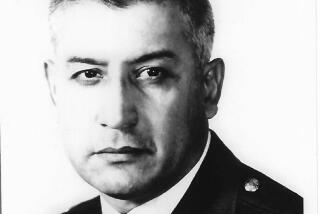Herbert S. Kirk, 106; WWI Pilot, Potter and Active Senior Athlete
- Share via
Herbert S. Kirk, the oldest surviving U.S. Navy pilot from World War I, died of pneumonia Wednesday at his home in Bozeman, Mont. He was 106, and had marked that birthday the day before his death.
A remarkably vital man, Kirk lived a full, active life as he approached the century mark and well after.
His accomplishments include graduating from Montana State University with a degree in art at the age of 97, becoming the oldest graduate in the school’s history.
In 1999, at the age of 104, he was one of several American veterans of World War I given the Legion of Honor, France’s highest award, for his part in preserving France during World War I.
But perhaps most remarkably, Kirk--a strong athlete throughout his life--was an active runner well past the age of 100.
In 1999, he became the oldest man to complete the annual Montana Governor’s 5K race, which he did by jogging with a dozen members of his family. At the age of 90, he was going for an hourlong run four to five mornings a week and covering about four miles.
“It keeps me in good shape, active, interesting,” Kirk told a reporter for “Good Morning, America” some years ago. “I wouldn’t do without some exercise. I’d be downhill fast.”
Kirk grew up in Newcastle, Pa., and played football in high school. He was also an active track athlete. He went on to Lehigh University, but when the United States entered World War I, Kirk and several of his classmates decided to enlist in the Navy Flying Corps.
Longing to become fighter pilots, Kirk and his pals had to be content to fulfill part of the Navy’s aerial role in the conflict, flying reconnaissance and bombing missions over the English Channel looking for German submarines.
Kirk became a night bomber on planes flying the channel. He recalled that “the bomb sights were rather primitive--a telescope with many cross hairs and a bubble level--but I learned to use it with some degree of proficiency.”
Returning to the United States after the armistice, Kirk eventually went back to the family business of making sinks, bathtubs and toilets. He later turned to making fine hand-painted dinnerware. He stayed in that trade until the mid-1950s, but decided to retire after business declined in the face of increased Japanese imports.
Kirk and his wife, Eleanor, retired to Bozeman, where she had family, when he was 60.
A lifetime tennis player, Kirk was in his early 90s when he found that his eyesight was starting to decline and he was having trouble picking up the ball. So on the advice of a colleague at Montana State University, where Kirk was offering pottery instruction and helping test Montana clay for its suitability for pottery, Kirk decided to take up running.
“So I started slowly,” Kirk told a reporter for the Arkansas Democrat years later. “Eventually, I was able to run a few miles, so I entered a masters meet for runners 40 and older. At the age of 87, I got into the national record books for my age division.”
His doctors were generally dumbfounded at his health and vigor.
“Well, mostly they just shake their heads when I come in for a checkup and tell me to keep on doing whatever I’ve been doing,” he told the Democrat.
And he offered some sound advice for beginning runners.
“I see some of these younger men who start running and get real gung-ho about it and soon they go crazy over running,” Kirk said. “Pretty soon, however, they aren’t running anymore. So I advise people to take it easy when they start.”
Kirk is survived by a son, Charles; a daughter, Marguerite Harris; five grandchildren; and 12 great-grandchildren.


